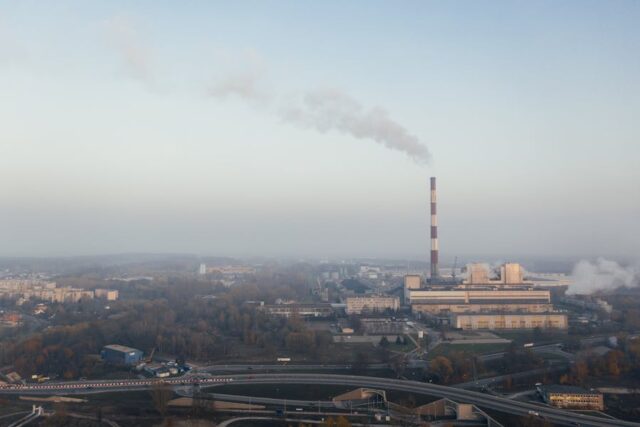No, oxygen is not a greenhouse gas. Oxygen gas, which is composed of two oxygen atoms connected with a double bond, lacks the molecular structure required to trap infrared radiation.
Therefore, it is unable to contribute to the greenhouse effect and is not classified as a greenhouse gas. Greenhouse gases, such as carbon dioxide, methane, and water vapor, have the ability to absorb and emit radiant energy within the thermal infrared range, which leads to the greenhouse effect.
However, oxygen does play a vital role in our atmosphere and is essential for sustaining life on Earth.
The Role Of Greenhouse Gases In Climate Change
Oxygen is not a greenhouse gas as it lacks the molecular structure to trap infrared radiation, unlike greenhouse gases such as carbon dioxide and methane. Greenhouse gases absorb and emit radiant energy, contributing to the greenhouse effect, which helps regulate the Earth’s temperature.
The Role of Greenhouse Gases in Climate Change
Greenhouse gases play a crucial role in regulating the Earth’s temperature. They absorb and emit radiation, which helps keep the planet warm enough to support life. However, an excess of greenhouse gases, such as carbon dioxide, methane, and nitrous oxide, can cause the Earth’s temperature to rise, resulting in climate change. In this blog post, we will explore the characteristics of greenhouse gases and common misconceptions about them, with a focus on the question: Is oxygen a greenhouse gas?
Characteristics Of Greenhouse Gases
Greenhouse gases have certain characteristics that make them effective at trapping heat. They have the ability to absorb and emit infrared radiation, which is the type of radiation that is responsible for heating the Earth’s surface. Additionally, greenhouse gases have a long lifespan, which means they can remain in the atmosphere for years, even decades, before being removed. The most common greenhouse gases are carbon dioxide, methane, and nitrous oxide, but water vapor is also a potent greenhouse gas.
Common Misconceptions About Greenhouse Gases
One common misconception about greenhouse gases is that they are inherently bad for the environment. While an excess of greenhouse gases can cause harm, they are necessary for regulating the Earth’s temperature and supporting life. Another misconception is that oxygen is a greenhouse gas. However, oxygen is not a greenhouse gas because it lacks the molecular structure necessary to trap infrared radiation. Oxygen gas is a diatomic molecule made of two oxygen atoms, and since it is only made from one element, it lacks the polarity necessary to absorb infrared radiation and vibrate. Therefore, oxygen cannot contribute to the greenhouse effect and is not considered a greenhouse gas.
In conclusion, greenhouse gases are crucial for regulating the Earth’s temperature, but an excess of them can cause climate change. Oxygen is not a greenhouse gas because it lacks the necessary molecular structure to trap infrared radiation. By understanding the characteristics of greenhouse gases and dispelling common misconceptions, we can work towards reducing their impact on the environment and mitigating the effects of climate change.
Oxygen’s Place In The Atmosphere
Oxygen, comprising approximately 21% of Earth’s atmosphere, plays a critical role in supporting life on our planet. While it is not considered a greenhouse gas, understanding its chemical structure and comparing it to greenhouse gases sheds light on its unique atmospheric function.
The Chemical Structure Of Oxygen
Oxygen exists as a diatomic molecule, with two oxygen atoms bound together by a double bond. This molecular structure lacks the polarity required to absorb and trap infrared radiation, essential for contributing to the greenhouse effect. As a result, oxygen does not exhibit the properties of a greenhouse gas, distinguishing it from compounds like carbon dioxide and methane.
Comparing Oxygen To Greenhouse Gases
- Oxygen, with its diatomic molecular structure, does not possess the ability to trap and emit thermal infrared energy, unlike greenhouse gases such as carbon dioxide and methane.
- Greenhouse gases, including carbon dioxide and methane, have molecular structures that enable them to absorb and emit radiant energy within the thermal infrared range, contributing to the greenhouse effect.
- While oxygen is vital for respiration and energy production, it does not exhibit the properties necessary to act as a greenhouse gas, making it distinct from the compounds that do contribute to the greenhouse effect.
Criteria For A Greenhouse Gas
Oxygen is not a greenhouse gas due to its molecular structure lacking the ability to trap infrared radiation. Greenhouse gases like carbon dioxide and methane have the capacity to absorb and emit radiant energy, contributing to the greenhouse effect and global warming.
In order for a gas to be considered a greenhouse gas, it must meet certain criteria. These criteria include:
- Infrared Absorption and Radiation: A greenhouse gas must have the ability to absorb and emit radiant energy within the thermal infrared range. This is crucial for trapping heat and contributing to the greenhouse effect.
- The Molecular Structure of Effective Greenhouse Gases: The molecular structure of a greenhouse gas plays a significant role in its ability to absorb and trap infrared radiation. Gases with certain molecular structures are more effective at this than others.
Infrared Absorption And Radiation
One of the key criteria for a gas to be classified as a greenhouse gas is its ability to absorb and radiate infrared (IR) energy. When sunlight reaches the Earth’s surface, it is absorbed and re-emitted as heat in the form of IR radiation. Greenhouse gases have the unique property of being able to absorb and re-emit this IR radiation, trapping it within the Earth’s atmosphere.
This trapping of IR radiation is what leads to the greenhouse effect, where heat is trapped in the atmosphere and contributes to global warming. Gases like carbon dioxide, methane, and water vapor are known for their strong IR absorption and radiation capabilities, making them significant contributors to the greenhouse effect.
The Molecular Structure Of Effective Greenhouse Gases
The molecular structure of a gas is crucial in determining its effectiveness as a greenhouse gas. Effective greenhouse gases have molecular structures that allow them to absorb and vibrate in response to IR radiation. This vibration leads to the trapping of heat within the atmosphere.
Oxygen, on the other hand, does not possess the molecular structure necessary to absorb and vibrate in response to IR radiation. Oxygen gas consists of two oxygen atoms connected by a double bond, resulting in a symmetrical molecular structure. This symmetry prevents oxygen from changing its dipole moment and vibrating, which is essential for absorbing IR radiation.
Since oxygen gas cannot effectively absorb IR radiation, it does not contribute to the greenhouse effect and is therefore not classified as a greenhouse gas.
In conclusion, while oxygen is an important component of our atmosphere, it does not meet the criteria to be considered a greenhouse gas. The ability to absorb and radiate infrared energy, along with the molecular structure, are key factors in determining whether a gas can contribute to the greenhouse effect.
Debunking Myths: Oxygen And The Greenhouse Effect
Is oxygen a greenhouse gas? Let’s debunk the myth and explore the relationship between oxygen and the greenhouse effect.
Why Oxygen Does Not Trap Heat
Oxygen is not a greenhouse gas due to its molecular structure. Oxygen gas consists of two oxygen atoms bonded together, lacking the polarity required to absorb infrared radiation. This inability to trap heat means that oxygen does not contribute to the greenhouse effect.
The Difference Between Oxygen And Ozone
Oxygen and ozone are often confused, but they serve different roles in the atmosphere. Oxygen (O2) is the gas we breathe, while ozone (O3) is a molecule made of three oxygen atoms. Ozone, unlike oxygen, can absorb and emit radiant energy within the thermal infrared range, making it a greenhouse gas.
Implications Of Misunderstanding Greenhouse Gases
Understanding the role of greenhouse gases in the Earth’s climate system is crucial for addressing environmental challenges. Misconceptions about greenhouse gases, including the belief that oxygen is a greenhouse gas, can have significant implications for how we approach climate science and environmental education.
The Danger Of Oversimplifying Climate Science
When discussing greenhouse gases, oversimplification can lead to misunderstandings and misconceptions. The complex interactions between various gases, such as carbon dioxide, methane, and water vapor, contribute to the greenhouse effect. Oversimplifying this concept by erroneously including oxygen as a greenhouse gas can perpetuate misinformation and hinder efforts to combat climate change.
Educational Approaches To Complex Environmental Topics
Effective environmental education should focus on accurate and nuanced explanations of complex topics like greenhouse gases. By emphasizing the specific properties and behaviors of different gases, educators can help students develop a more comprehensive understanding of the greenhouse effect and its implications for global climate patterns.
Frequently Asked Questions
Is Oxygen A Greenhouse Gas Or Not?
Oxygen is not a greenhouse gas as it lacks the molecular structure to trap infrared radiation.
Which Gases Are Greenhouse?
Greenhouse gases include carbon dioxide, methane, water vapor, and nitrous oxide. Oxygen is not a greenhouse gas.
Why Is Co2 A Greenhouse Gas And O2 Not?
CO2 is a greenhouse gas because it traps heat due to its molecular structure. O2 lacks this structure, so it doesn’t act as a greenhouse gas.
What Are The 4 Main Greenhouse Gases?
The four main greenhouse gases are carbon dioxide, methane, nitrous oxide, and fluorinated gases.
Faq 1: Is Oxygen Considered A Greenhouse Gas?
No, oxygen is not considered a greenhouse gas because it lacks the molecular structure required to trap infrared radiation and contribute to the greenhouse effect.
Faq 2: Why Is Oxygen Not Classified As A Greenhouse Gas?
Oxygen gas is not classified as a greenhouse gas because its molecular structure, consisting of two oxygen atoms bonded together, does not allow it to absorb infrared radiation and vibrate like greenhouse gases do.
Conclusion
Oxygen is not a greenhouse gas. It lacks the molecular structure necessary to absorb and trap infrared radiation, which is required for a gas to contribute to the greenhouse effect. While some compounds containing oxygen, such as carbon dioxide and ozone, are greenhouse gases, oxygen itself is not. Understanding the science behind greenhouse gases and their effects on our planet is important for making informed decisions about reducing our carbon footprint.














